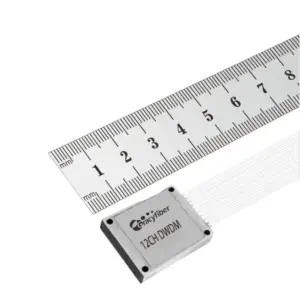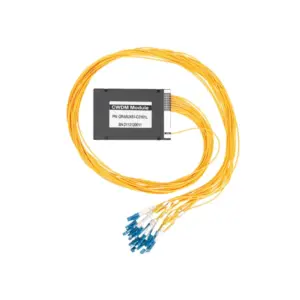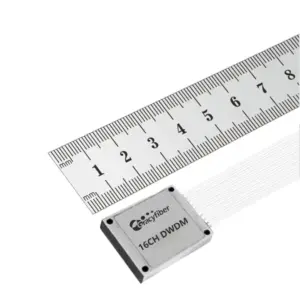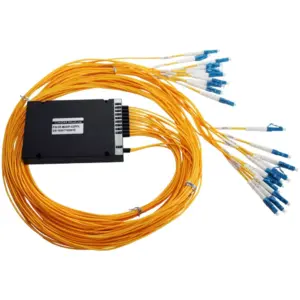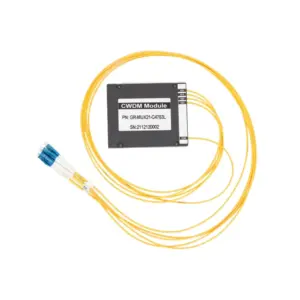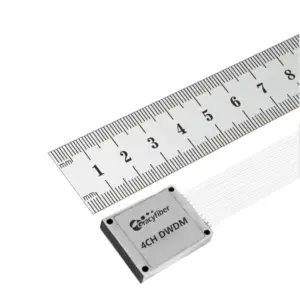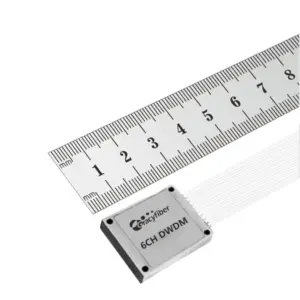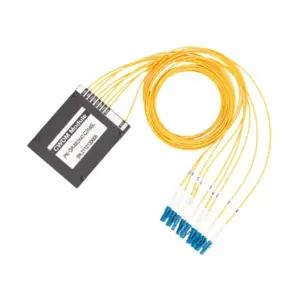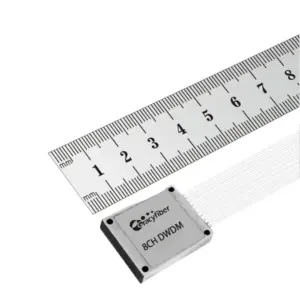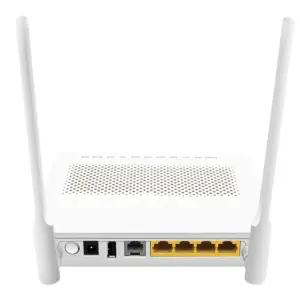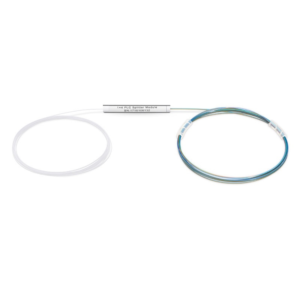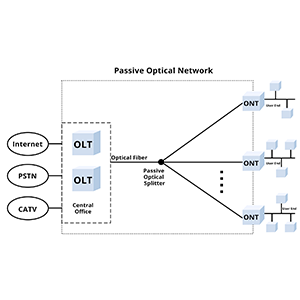I am pleased to introduce to you CWDM (Coarse Wavelength Division Multiplexing) and DWDM (Dense Wavelength Division Multiplexing) technologies. Both technologies are optical wavelength division multiplexing technologies used to achieve efficient optical fiber transmission and multi-wavelength data transmission. In this article, I will introduce the definition, basic principles of CWDM and DWDM technologies, as well as their characteristics and uses in the field of optical wavelength division multiplexing.
CWDM and DWDM technologies use different optical wavelengths to combine multiple data signals into one optical fiber to transmit multiple independent signals at the same time. They implement multiplexing and demultiplexing based on different spectral ranges and optical wavelength intervals.
Introduction to CWDM and DWDM technology
Definition and rationale:
CWDM (Coarse Wavelength Division Multiplexing) and DWDM (Dense Wavelength Division Multiplexing) are two forms of optical wavelength division multiplexing (WDM) technology, used to achieve simultaneous transmission of multiple signals in optical fiber transmission.
CWDM technology distributes different optical signals to different wavelengths and usually works within an optical frequency band with a narrow wavelength range. CWDM systems typically use wider channel spacing, such as 20 nanometers (nm), to differentiate between different wavelengths. It is suitable for shorter distance transmission and lower capacity networks, usually supporting less than 10 wavelengths.
DWDM technology utilizes light wavelengths more densely, typically using narrower channel spacing, such as 0.8 nanometers (nm) or less. It can transmit a large number of signals simultaneously in optical fiber, supporting dozens or even hundreds of wavelengths. DWDM systems can be used for long-distance transmission and high-capacity networks, and can meet the transmission needs of large-capacity data.
Optical wavelength division multiplexing technology:
CWDM and DWDM, as optical wavelength division multiplexing technologies, have the following characteristics and uses:
-
High bandwidth utilization: CWDM and DWDM technologies can simultaneously transmit multiple signals on different wavelengths in the optical fiber to achieve efficient utilization of optical fiber bandwidth. By transmitting different signals at different wavelengths, multiple communication signals can be transmitted in the same optical fiber, improving transmission capacity and bandwidth utilization.
-
High density and high capacity: DWDM technology, in particular, can achieve high density and high capacity optical fiber transmission due to its smaller channel spacing and ability to support a large number of wavelengths. This makes DWDM technology widely used in scenarios such as large data centers, optical transport networks, and long-distance communications.
-
Flexibility and scalability: CWDM and DWDM systems are flexible and scalable, and signals of specific wavelengths can be added or deleted as needed. This enables network operators and enterprises to adjust and expand capacity according to actual needs without having to replace the entire fiber optic transmission system.
-
Compatibility: CWDM and DWDM technologies are compatible with traditional optical fiber transmission systems and can be integrated with other optical network equipment. This makes them ideal for upgrades and expansions of existing networks without the need for wholesale changes to the entire network infrastructure.
In summary, CWDM and DWDM technologies, as optical wavelength division multiplexing technologies, achieve simultaneous transmission of multiple signals by using different optical wavelengths, improving the bandwidth utilization and capacity of optical fiber transmission. They play an important role in different application scenarios and meet the needs of modern communication networks for high bandwidth, high density and flexibility.
Applications and characteristics of CWDM technology
Application scenarios:
CWDM technology has a wide range of applications in different fields, including but not limited to the following fields:
-
Data center: CWDM technology can be used for optical fiber interconnection in data centers to achieve high-speed data transmission between servers. It can effectively provide connectivity and expansion within the data center and meet the data center’s requirements for high bandwidth and low latency.
-
Enterprise network: CWDM technology can be used for optical fiber connections in enterprise networks to connect network devices between different floors, remote office locations, or branches. It provides reliable high-speed connectivity to support intra-enterprise communication and data transmission needs.
-
Wireless communications: CWDM technology is also used in the field of wireless communications. For example, in optical fiber transmission between mobile communication base stations, CWDM can achieve high-speed data transmission between multiple base stations, providing more stable and efficient signal transmission.
-
Video surveillance: CWDM technology can be used for optical fiber transmission in video surveillance systems to connect surveillance cameras and surveillance centers. It provides high-quality video transmission and real-time monitoring and is suitable for various scenarios, such as urban security, traffic monitoring, and enterprise monitoring.
Number of lightwave channels:
The number of optical wave channels supported by CWDM technology is relatively small, usually between a few and a dozen wavelengths. Common CWDM systems usually support 8 wavelengths (channels), with 20 nanometers (nm) between each wavelength. This makes CWDM technology suitable for medium-capacity data transmission needs, such as general enterprise networks or smaller-scale data centers.
Because the channel spacing of CWDM technology is large and the interference between wavelengths is small, the manufacturing and maintenance costs of the equipment are relatively low. In addition, CWDM technology is also flexible and scalable, and signals of specific wavelengths can be added or deleted as needed to adapt to changes in network capacity.
However, it is important to note that as network demands grow, the capacity of CWDM technology may be limited. When higher capacity and more optical wave channels are required, higher-density optical wavelength division multiplexing technology, such as DWDM technology, can be considered to meet network transmission with higher bandwidth requirements.
Spectral range of CWDM and DWDM
Light wavelength range:
CWDM (Coarse Wavelength Division Multiplexing) and DWDM (Dense Wavelength Division Multiplexing) technologies are different in spectral range.
The wavelength range covered by CWDM technology is relatively narrow. Typically, CWDM systems use wavelengths ranging from 1260 nanometers (nm) to 1620 nanometers (nm). Within this wavelength range, CWDM typically supports 8 wavelengths (channels), each separated by 20 nanometers.
The wavelength range covered by DWDM technology is relatively wide. Generally speaking, DWDM systems use wavelengths ranging from 1525 nanometers to 1610 nanometers or wider, which covers the C-band and L-band. DWDM technology can support many more wavelengths, often reaching dozens or even hundreds of wavelengths, with the spacing between each wavelength typically being 0.8 nanometers or less.
Light wavelength interval:
Optical wavelength spacing refers to the distance between adjacent wavelengths in CWDM and DWDM systems.
In CWDM technology, the optical wavelength spacing is typically 20 nanometers. This means that adjacent CWDM wavelengths are separated by 20 nanometers. For example, one wavelength might be 1310 nanometers, the next might be 1330 nanometers, the next might be 1350 nanometers, and so on.
In DWDM technology, the optical wavelength spacing is usually 0.8 nanometers or less. This means that adjacent DWDM wavelengths are separated by 0.8 nanometers or less, for example, one wavelength might be 1550.12 nanometers, the next might be 1550.92 nanometers, the next might be 1551.72 nanometers, and so on.
Because DWDM technology has smaller optical wavelength intervals, more optical wavelengths can be implemented over a wider wavelength range, providing higher capacity and bandwidth.
In summary, the spectrum range of CWDM technology is narrow, usually covering the wavelength range from 1260nm to 1620nm, and the optical wavelength interval is 20nm. The spectrum range of DWDM technology is wider, usually covering a wavelength range from 1525nm to 1610nm or wider, and the optical wavelength interval is 0.8nm or less.
CWDM and DWDM optical modules and equipment
Optical module type:
The types of optical modules used in CWDM and DWDM technologies are related to transmission distance and capacity requirements. The following are common optical module types:
-
SFP (Small Form-Factor Pluggable): The SFP module is a small pluggable optical module used to transmit lower-capacity optical signals. For CWDM and DWDM technologies, there are CWDM SFP modules and DWDM SFP modules that can be used for optical transmission of the corresponding technologies.
-
XFP (10 Gigabit Small Form Factor Pluggable): The XFP module is a small pluggable optical module with a 10G rate, suitable for higher capacity optical transmission requirements. CWDM and DWDM technologies also have corresponding CWDM XFP modules and DWDM XFP modules.
-
QSFP (Quad Small Form-Factor Pluggable): The QSFP module is an optical module that supports high density and high capacity and can provide 40G or higher rate transmission. Similarly, CWDM QSFP modules and DWDM QSFP modules can be used for optical transmission of CWDM and DWDM technologies.
Other types of optical modules, such as CFP, CXP and OSFP, can also be used for higher capacity optical transmission needs, but for general medium capacity needs, SFP, XFP and QSFP are the more common optical module types.
Internet equipment:
Network equipment that supports CWDM and DWDM technology includes but is not limited to the following types:
-
Optical transmission equipment: Optical transmission equipment is used for optical signal transmission in CWDM and DWDM technology. These devices include CWDM transmission equipment and DWDM transmission equipment, which are used to send and receive optical signals for optical fiber communications, and perform wavelength division multiplexing and demultiplexing.
-
Optical switch: Optical switch is used to realize the switching and routing of optical signals. It can switch optical signals from one input channel to multiple output channels, or switch multiple input channels to one output channel. Optical switches play a key role in CWDM and DWDM systems and are used to protect optical paths, adjust capacity, and increase network flexibility.
-
Optical multiplexer (MUX/DEMUX): Optical multiplexer is used to combine multiple optical signals (different wavelengths) into one optical fiber, or to separate multiple optical signals in one optical fiber. Optical multiplexers in CWDM and DWDM systems play an important role in realizing multiplexing and demultiplexing of multi-wavelength optical signals.
In addition, there are other auxiliary equipment, such as optical amplifiers (EDFA, Raman amplifier, etc.), optical monitoring equipment and optical fiber connectors, etc., which are used in CWDM and DWDM systems to enhance signal transmission, monitor network performance and provide reliable optical connect.
To sum up, CWDM and DWDM technologies use different types of optical modules, such as SFP, XFP and QSFP, to meet different capacity requirements. At the same time, network equipment that supports CWDM and DWDM technology includes optical transmission equipment, optical switches, and optical multiplexers, which are used to realize the transmission, scheduling, and multiplexing of optical signals.
Deployment and configuration of CWDM and DWDM
Fiber optic cabling:
Fiber optic cabling for CWDM and DWDM technologies requires the following steps to be considered:
-
Connect the optical module: First, insert the CWDM or DWDM optical module into the optical module slot of the corresponding optical transmission equipment (such as a switch, router or optical transmission platform). Make sure the slot is compatible with the type and interface of the optical module.
-
Fiber optic connection: Use fiber optic connectors to physically connect the optical module to the optical fiber. Make sure to use the correct type of optical fiber connector (such as LC, SC or MPO, etc.) and make connections according to the type of interface between the optical module and the optical transmission device.
Light splitting and combining: If multiple wavelengths need to be transmitted on the same optical fiber, a beam splitter (CWDM) or combiner (DWDM) needs to be used to separate and combine wavelengths.
-
CWDM optical splitter: CWDM optical splitter separates optical signals of different wavelengths into different optical fiber channels, or combines optical signals in multiple optical fiber channels into one optical fiber.
-
DWDM optical combiner: DWDM optical combiner combines optical signals of different wavelengths from multiple optical fiber channels into one optical fiber, or separates multiple optical signals in one optical fiber into different optical fiber channels.
-
By correctly configuring and connecting CWDM or DWDM optical splitters/combiners, multi-wavelength optical signal transmission and multiplexing can be achieved.
Network Configuration:
Network configuration of CWDM and DWDM technology includes the following aspects:
-
Wavelength allocation: For CWDM systems, it is necessary to determine the communication channels and optical fiber connections corresponding to each wavelength. A CWDM system typically supports 8 wavelengths (channels) with 20 nanometers between each wavelength. Determine the purpose and allocation of each wavelength based on network needs.
For example, in a CWDM system, wavelength 1 can be assigned to data center A, wavelength 2 can be assigned to data center B, and so on. This way, each data center can communicate using independent wavelengths.
For DWDM systems, more detailed wavelength allocation is required because DWDM systems can support more wavelengths. Each wavelength is typically associated with a specific communications channel and fiber optic connection.
Optical power management: In CWDM and DWDM systems, optical power management is one of the important configuration tasks. Ensure that the optical power of each wavelength is within the appropriate range to ensure the quality and reliability of the optical signal.
-
Optical power monitoring: Use an optical power meter or optical monitoring equipment to monitor the optical power of each channel. Determine the target power range for each wavelength based on equipment specifications and manufacturer recommendations.
-
Optical power adjustment: Adjust the transmit power of each wavelength based on the optical power monitoring results. Optical power can be increased or decreased using devices such as optical amplifiers (EDFA) or adjustable optical attenuators.
-
Through appropriate wavelength allocation and optical power management, stable and reliable optical signal transmission in CWDM and DWDM systems can be ensured.
It should be noted that the deployment and configuration of CWDM and DWDM may vary depending on specific equipment and manufacturers. During the actual deployment and configuration process, it is recommended to refer to the documentation and guidance provided by the device vendor to ensure correct operation and configuration.
Summarize:
CWDM and DWDM technologies, as optical wavelength division multiplexing technologies, provide efficient and high-capacity solutions for optical fiber transmission. They have their own advantages in applications and characteristics in different fields, and the appropriate technology can be selected according to actual needs.
As network demands continue to grow, CWDM and DWDM technologies have broad development prospects. In the future, there may be higher numbers of optical channels and more the high transmission rate further promotes the progress of network technology.
If you have any further questions about CWDM and DWDM technology or want to know more information, please continue to pay attention to GracyFiber Company, we will be happy to help you. Thanks!


